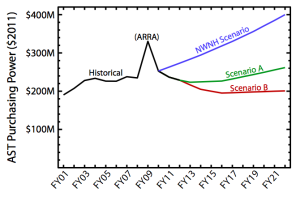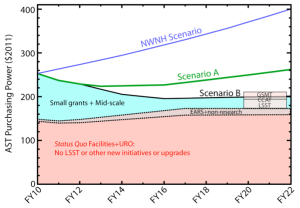Scary times for our US chums. The dreaded NSF Portfolio Review finally did its thing. The news is pretty bad in places, but to be honest I think its less to do with our austere times than it is to do with historic overheating and the “funding wall” problem.
You can find the full report at this web page here . Stein Siggywatsit at Dynamics of Cats has already digested the report and written a nice commentary . Under the harsher but probably realistic “Scenario B”, here are the headlines :
- ALMA, Gemini, EVLA, Blanco, and grants protected
- LSST and ATST get a go ahead;
- GSMT, CCAT will maybe get some peanuts
- Mayall, KP 21.m, WIYN, GBT, VLBA out
I skimmed the report and found two figures illuminating. The first figure shows the evolution of the NSF Astronomy budget.


This shows what it costs to just keep all the current commitments running. The boxes labelled LSST, CCAT, GSMT are the likely operating cost contributions, not the construction costs.
So basically what you see is that the US has done such wonderful things in the past, that if we keep them all going – especially the very newest things like ALMA – that uses up all the money forever. You want LSST, ATST, CCAT ? OK. What are you chopping ? Thats it.
The trouble with Big Science is that it is only ever worth doing things that are much better than before. The squeeze is ineluctable.
